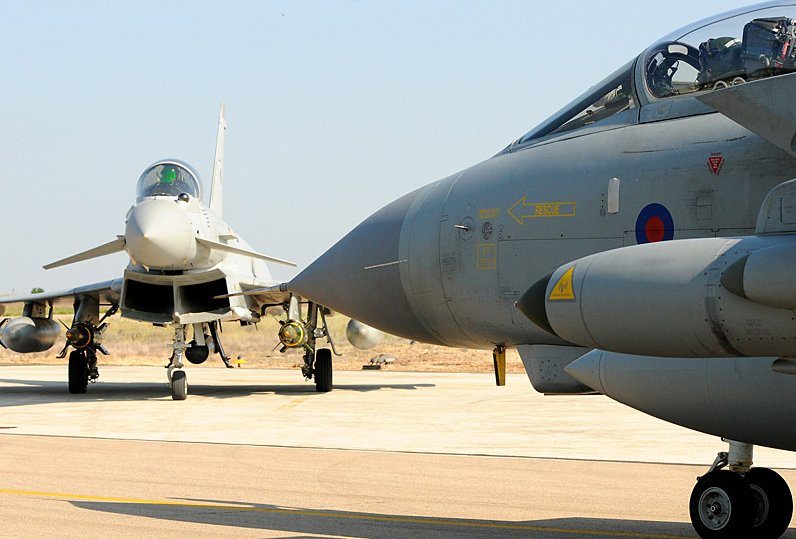As street fighting continues in Tripoli between Free Libya Forces and members of Colonel Gaddafi’s former regime, British and NATO military aircraft are maintaining a presence in the air.
In the lead up to Free Libya Forces entering Tripoli this weekend the RAF continued to strike at key Colonel Gaddafi targets within the city as part of NATO’s Operation UNIFIED PROTECTOR.
On Sunday morning RAF Tornado and Typhoon aircraft mounted a precision strike before dawn on the military intelligence operations room in Tripoli, close to the Baroni intelligence facility which the RAF had successfully bombed 24 hours previously.
Nine Paveway guided bombs were delivered with great accuracy to the target.
Later in the day, an armed reconnaissance patrol identified and destroyed one of Gaddafi’s main battle tanks positioned on the outskirts of the city.
At sea, HMS Liverpool was conducting surveillance off Tripoli when she sighted a small Maltese-registered vessel which had been damaged by hostile fire while leaving Tripoli port, apparently with evacuees embarked.
The vessel was under way but her manoeuvrability was impaired. HMS Liverpool passed a line to the vessel and towed her to open water where she was able to proceed safely. Liverpool alerted the Maltese authorities to the vessel’s condition, and was then able to return to her duties off the coast.
In the early hours of Saturday morning, RAF Tornado GR4s conducted a precision strike on a key communications facility in south west Tripoli, used by the former regime intelligence organisations headed by Abdullah Senussi, concealed in a building known as the Baroni Centre.
Major General Nick Pope, the Chief of the Defence Staff’s Communications Officer, said:
“As ever, with a target in the heart of the city, extreme care was taken in planning the mission to ensure any risk of civilian casualties was avoided.
“Five precision-guided Paveway bombs made direct hits on the building.
“Heading south from Tripoli, the RAF aircraft then detected one of Gaddafi’s main battle tanks on the outskirts of the city and destroyed it with a further Paveway weapon.”
“As ever, with a target in the heart of the city, extreme care was taken in planning the mission to ensure any risk of civilian casualties was avoided.”
Major General Nick Pope
During the course of Saturday afternoon, an RAF patrol successfully engaged an artillery piece on the western edge of Tripoli, and attacked a nearby command and control facility.
Around midnight, Tornado and Typhoon aircraft destroyed another command and control facility, located in south west Tripoli, then proceeded east to Sirte, 240 miles (386km) away, to destroy a third such installation.
In the early hours of Friday morning, three formations of RAF aircraft mounted a co-ordinated strike on a group of warehouses at the site of the Central Organisation for Electronic Research (COER) in Tripoli.
The main buildings of the COER, a long-standing cover organisation for Libyan intelligence activities, including the development of weapons of mass destruction prior to 2003, were destroyed by an RAF attack on 24 July.
However, NATO surveillance demonstrated that the adjoining warehouses remained in use as an intelligence command and control node. One main battle tank, spotted by our aircraft in the vicinity of Tripoli, was also targeted successfully.
On Friday evening, two more formations of RAF Tornado and Typhoon aircraft returned to Tripoli. Their target was the main operations room for the Ministry of Interior’s security forces, which NATO intelligence had identified as located in a compound in the Abu Salim district. Eight Paveway guided bombs scored direct hits.
On Thursday morning, RAF patrols successfully attacked two staging areas used by Gaddafi’s forces at Zlitan, as well as a mobile radar system positioned nearby at Al Khums.
In the course of the afternoon, further armed reconnaissance patrols conducted precision strikes on a total of three locations in and around Az Zawiyah.
Fleet Air Arm Sea Kings from HMS Ocean, equipped with the very capable Searchwater radar, supplemented NATO’s fixed wing surveillance capabilities.
Major General Pope added:
“The strike missions flown by the RAF and other allied fast jets were only made possible by the large fleet of combat support aircraft mustered by NATO, including Royal Air Force VC10 and TriStar tankers, plus Sentry, Sentinel and Fleet Air Arm Sea King surveillance platforms.”
Since the start of military operations on 19 March, Royal Navy, Royal Air Force and Army Air Corps strikes have damaged or destroyed over 890 former regime targets which posed a threat to the Libyan people, ranging from secret police and intelligence headquarters to several hundred tanks, artillery pieces and armed vehicles.
UK missions over Libya are undertaken as part of NATO’s Operation UNIFIED PROTECTOR to enforce United Nations Security Council Resolution 1973 and protect Libyan civilians at risk of attack.
UK forces currently deployed on this operation include:
- RAF Tornado and Typhoon aircraft based at Gioia del Colle in Italy
- RAF VC10 and TriStar air-to-air refueling tankers based in Sicily and the UK
- RAF Sentry and Sentinel surveillance aircraft based in Sicily and Cyprus
- HMS Ocean (helicopter carrier)
- HMS Liverpool (Type 42 destroyer)
- HMS Bangor (Sandown Class minehunter)
- Royal Fleet Auxiliary vessel Fort Rosalie
- British Army Apache attack helicopters
- Fleet Air Arm Sea King helicopters (Airborne Surveillance and Area Control role)
- RAF air transport aircraft providing extensive logistic support to the deployed bases in Italy, Sicily and the Sovereign Base Areas in Cyprus.










